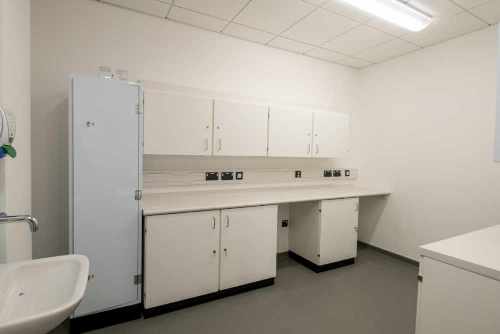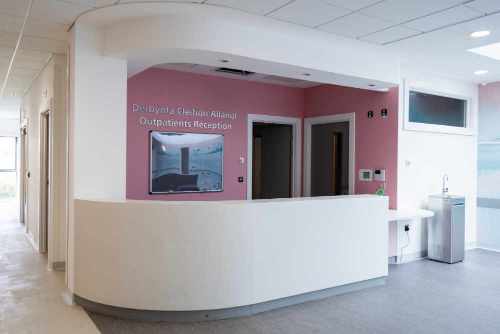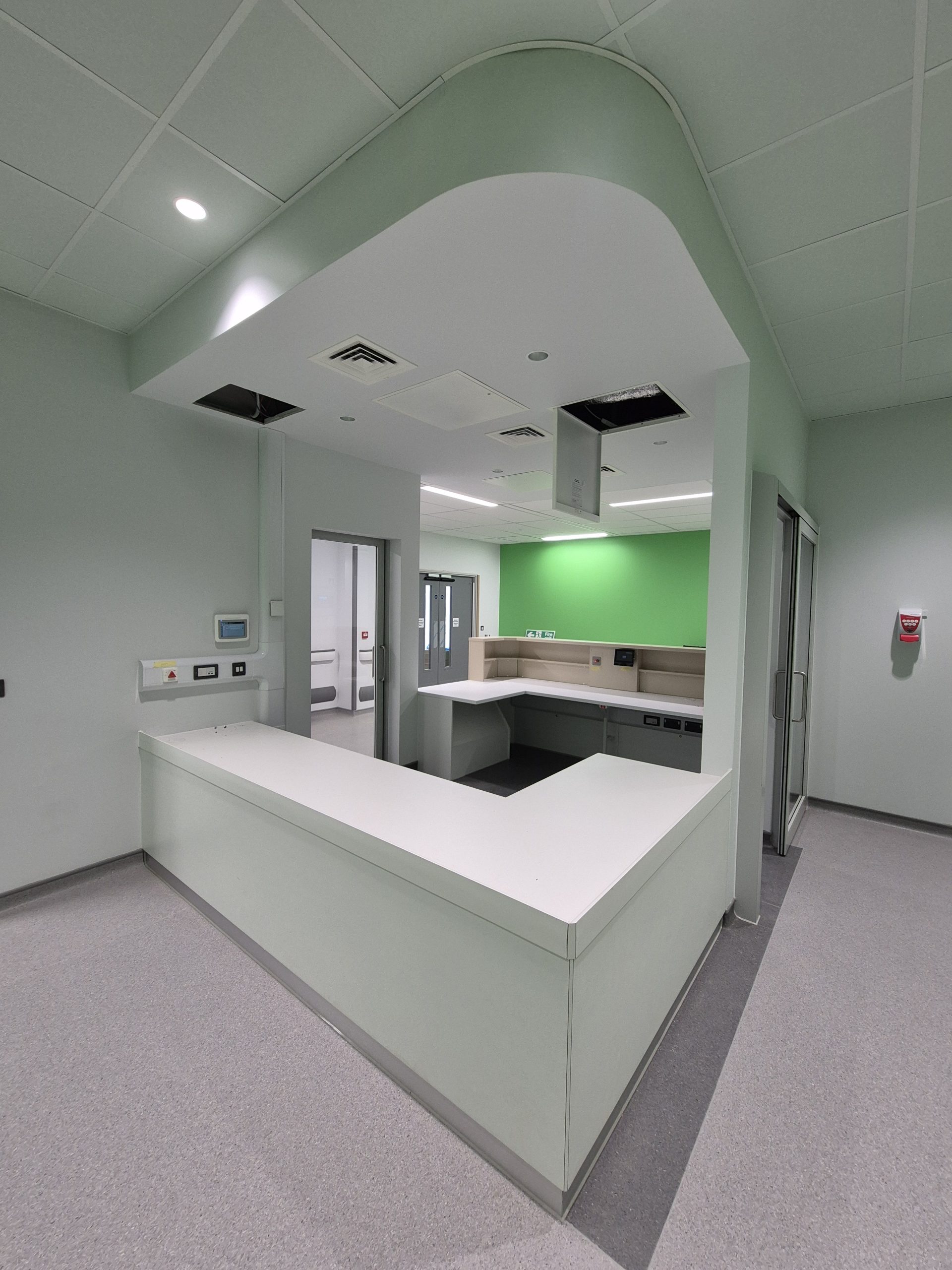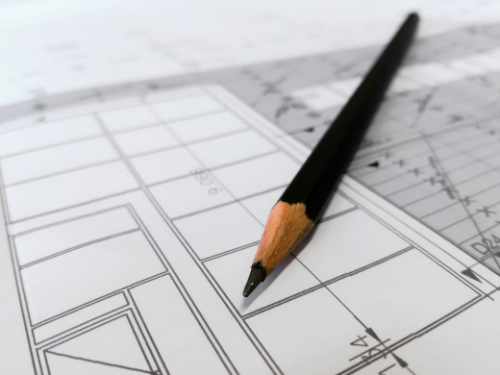Inside the main entrance of a busy NHS hospital is the reception desk. It stands…

How to open up a GP surgery to be COVID-19 safe
Healthcare has been on people’s minds now more than ever. Especially with the COVID-19 pandemic, attention is now greatly focused on healthcare buildings, such as hospitals and GP surgeries, and what they are doing to help reduce infection spread and disease control. Most people, however, don’t think about the part furniture can play in infection control and spreading diseases. Furniture and fitted healthcare furniture have been found to play a part in the spread of disease and infections, as a recent study shows that the variable of the virus can live up to 2-3 days on plastic and stainless steel. So, with that in mind, how to open up a GP surgery to ensure that everything, even down to your furniture, is COVID-19 safe for you and your patients?
Ensuring industry standards
The first thing to do is to ensure that your furniture complies with current HTM 63 and HTM 71 standards. HTM 63 and 71 is the Healthcare Technical Memorandum, which are NHS standards that must be adhered to when you are selling furniture for a healthcare situation and environment.
Anything from furniture to fittings must all comply with these standards and state that they must, for example, be non-porous, seamless and stain-resistant. They also state that such furniture must be made and fitted in a way that makes frequent and thorough cleaning of the floors and surfaces possible.
Where to source furniture for infection control

Not sure where to go for this? Look for a highly reputable source of hospital-grade healthcare furniture. We are a specialist British manufacturer, specialising in fitted furniture for healthcare and hospital markets, and have been favourite suppliers for NHS and private hospitals as well as doctor surgeries, clinics, and nursing homes.
Our Healthline furniture range is HTM 63 and 71 compliant, meaning you can purchase any equipment and fittings with complete peace of mind. For more information on our HTM 63 and 71 compliant furniture, check out our HTM 63 storage units and HTM 71 storage units.
Choosing the best materials
When considering what furniture to buy, you must also consider what it is made of. Avoid a material like wood as it is porous, leaving them susceptible to cross-contamination of infection and diseases. They are also very easily damaged and scratched, again making it hard to clean and to keep sterile.
Materials such as Velstone (a type of glass-ceramic), Corian and laminate are best as they are sterile, non-porous and easy to clean. They also comply with all the industry standards while being stain and scratch-resistant, budget-friendly and affordable to repair and replace, making them ideal for the base of any furniture and fitting for your GP surgery.
Design is key

The design and construction of any furniture or fittings can have an impact on its ability to either help or hinder the spread of infection.
For example, if you had a fabric or wooden chair and it became soiled or damaged in any way, it is very hard to clean it deeply, leaving all those who touch it susceptible to infection and risk. Whereas, if you had a seat with a waterproof, coated and removable cushion, if that became damaged or soiled, it is easy to take it off and to replace it with a clean spare.
An added benefit to such designs is that you can use anti-bacterial and viral cleaners that comply with current regulations, without the fear of damaging the product or harming it.
Another effective design point to keep in mind is furniture with sloping tops. Having a sloping top on something like a cupboard prevents dust from gathering and lying on it, which not only affects infection control but can prevent breathing and lung issues from affecting your staff and patients. Joins on items such as chairs, desks and cupboards should also be smooth and seamless.
Simple yet beneficial
An obvious yet often overlooked and highly effective design point is to have smooth surfaces on your furniture and fittings. Smooth surfaces are easy to clean on a regular basis, preventing long-term build-up and reducing the risk of dust, dirt and diseases collecting and spreading.
By taking the time to consider the design of your chosen furniture and fitted healthcare furniture, you can help improve the cleanliness of your surgery in the long term. For more information, check out our Infection Control in Hospital Furniture blog.
We have numerous options that combine sterile materials with effective designs, complying with industry standards, to provide you with the very best in healthcare furniture and fittings.
How to open up a GP surgery to be COVID-19 safe
When opening your GP surgery, there are numerous points to keep in mind to prevent the spread of infection, including your furniture and fittings. By taking the time to consider these points, you can ensure that your GP surgery opens to be COVID-19 safe. At David Bailey Furniture Systems, we have manufactured and installed reception counters and storage furniture at many GP surgeries, health centres and clinics, including:
- Cardigan Health Centre – click to read case study
- Sovereign Harbour Medical Centre, Eastbourne – click to read case study
- Leavesden Doctors Surgery, Hertfordshire – click to read case study
- Ashley Centre Surgery, Epsom
- Gossoms End Surgery, Berkhamsted
- Meridian Surgery, Peacehaven – click to read case study
Where to find out more
You can see our range of hospital and healthcare furniture here.
Visit our Resource Centre, containing Revit BIM drawings, colour cards, proposal templates, sample clean room layout in BIM format and our brochure, all downloadable without the need to log in or register.
Or please get in touch with us to discuss a project.








